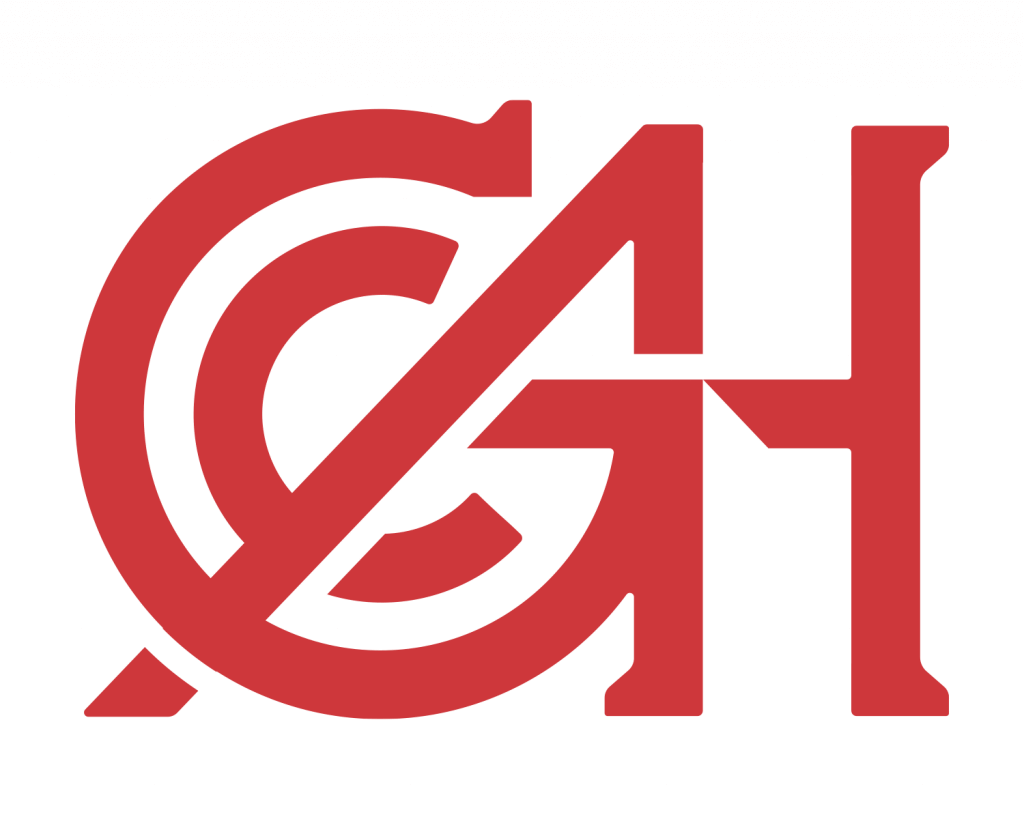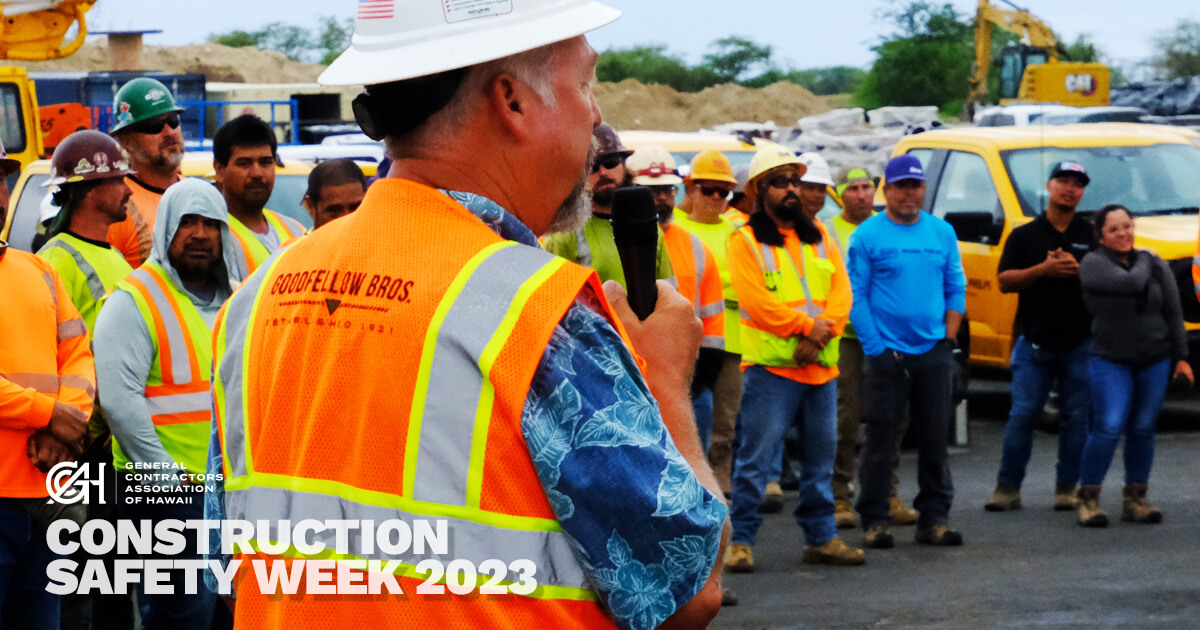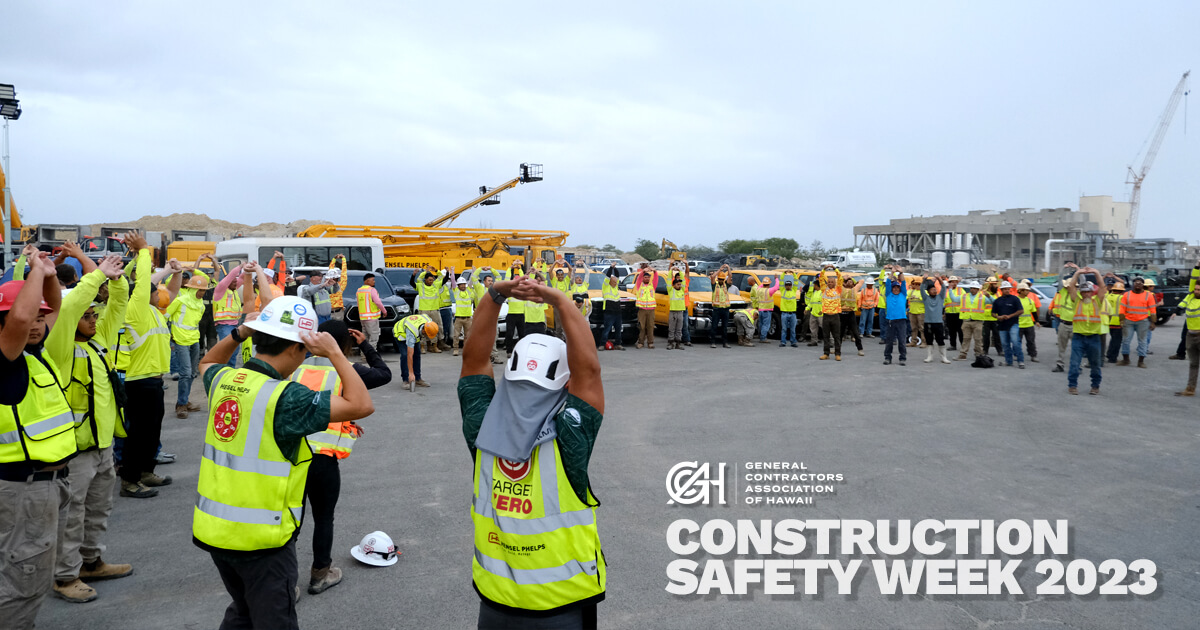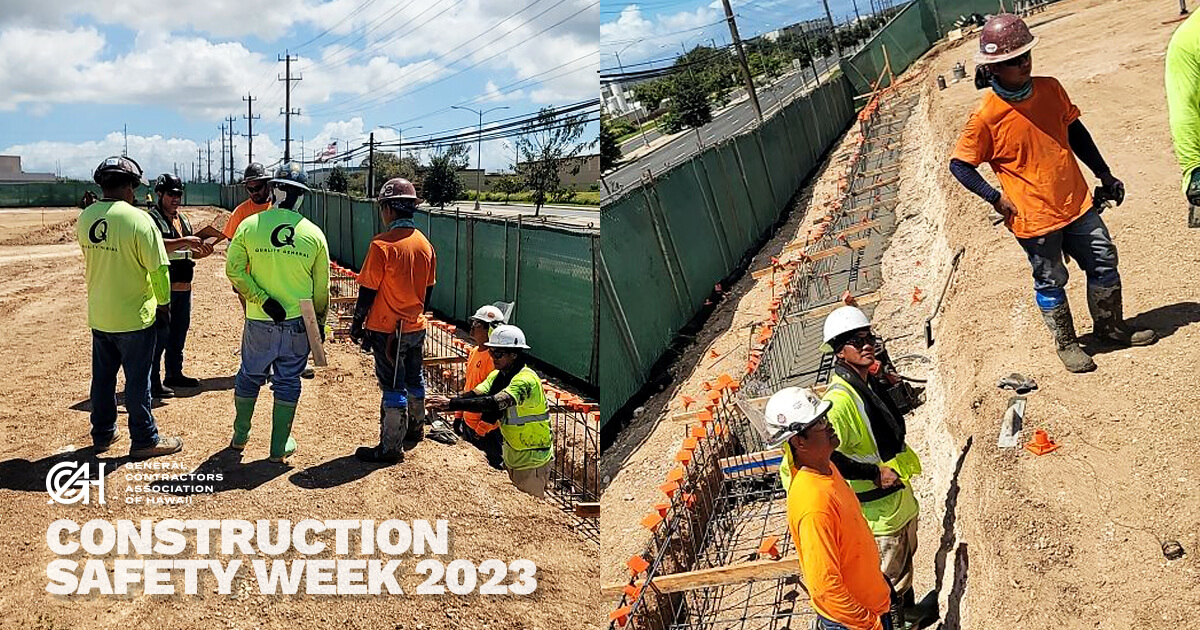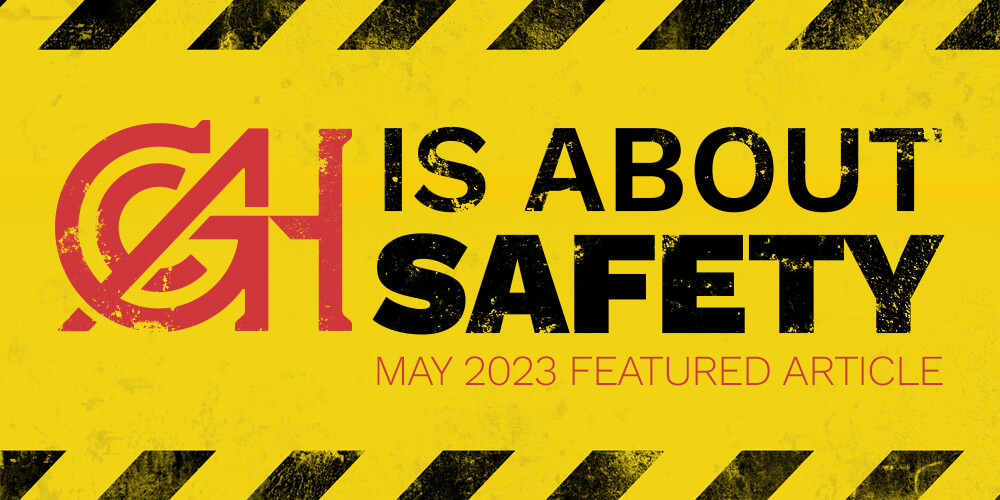
GCA is about SAFETY!
Safety is at the heart of the GCA and our members. To highlight this, the GCA kicked off the national Construction Safety Week (May 1 to 5) with a safety stand-down and demonstration at the Sand Island Wastewater Treatment Center.
More than 100 construction professionals from Hensel Phelps who were working at the Sand Island job site gathered for a safety stand-down. They started with morning stretching exercises and then Tristan Aldeguer, CSP, CHST, Senior Safety Manager with Hensel Phelps, shared an uplifting message about the importance of safety.
INTEGRATING TECHNOLOGY FOR SAFER JOB SITES
The stand-down continued with a heavy equipment safety demonstration. Vince George, Project Manager with Goodfellow Bros, explained how new sensor technology on an excavator can detect blind spots to prevent workers on the ground from being accidentally struck. The sensor technology works similarly to cameras installed on cars' dashboards, enabling drivers to see areas on the sides or back of their vehicles.
“Innovations like these are preventing injuries and saving lives.”
- Adam Cotton
Director of Safety and Health, Hensel Phelps
“Innovations like these are preventing injuries and saving lives,” said Adam Cotton, director of safety and health with Hensel Phelps, who was named the 2022 Safety Professional of the Year by the American Society of Safety Professionals, Hawaii Chapter.
Safety supports the construction industry. Removing safety hazards on job sites prevents injuries or deaths and supports the construction industry overall.
More on this event here.
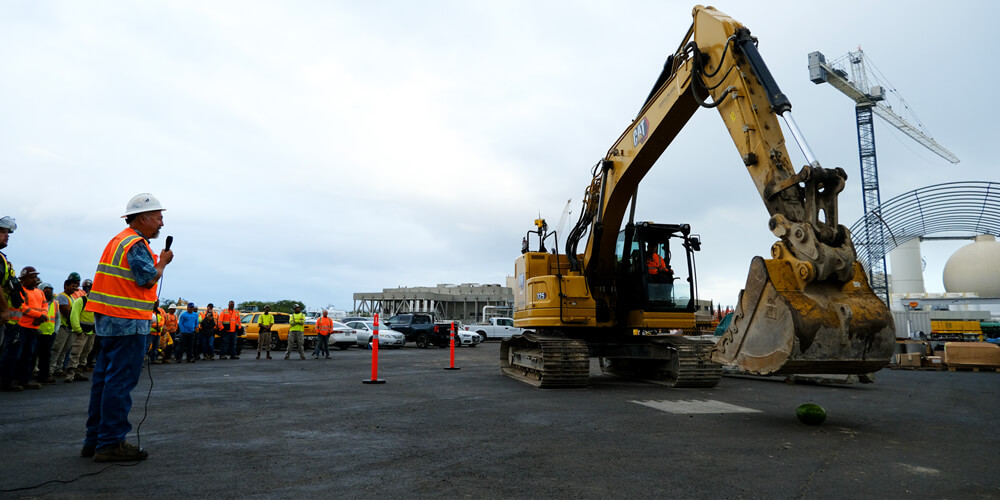
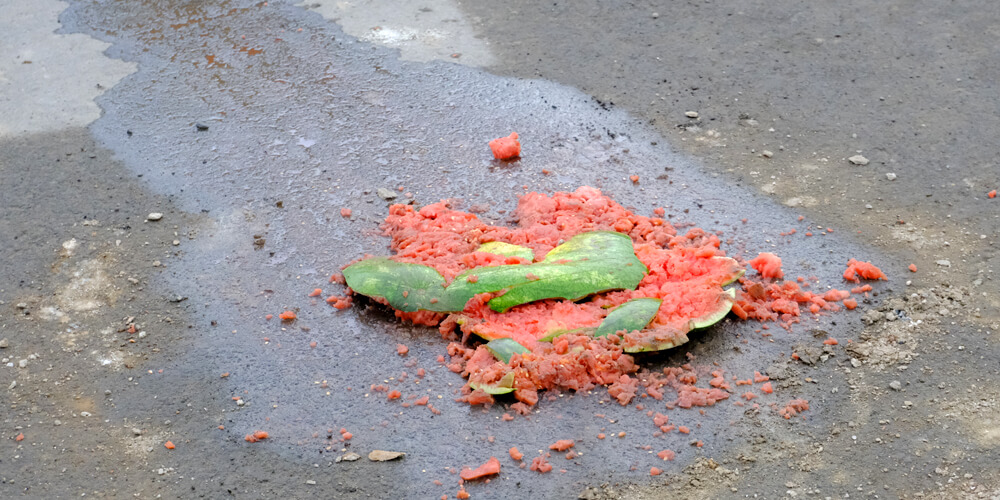
Using a watermelon, Hensel Phelps and Goodfellows Bros, members of the General Contractors Association of Hawaii, demonstrated what can happen when the bucket of an excavator is not installed properly and the potential impact on workers at a job site.
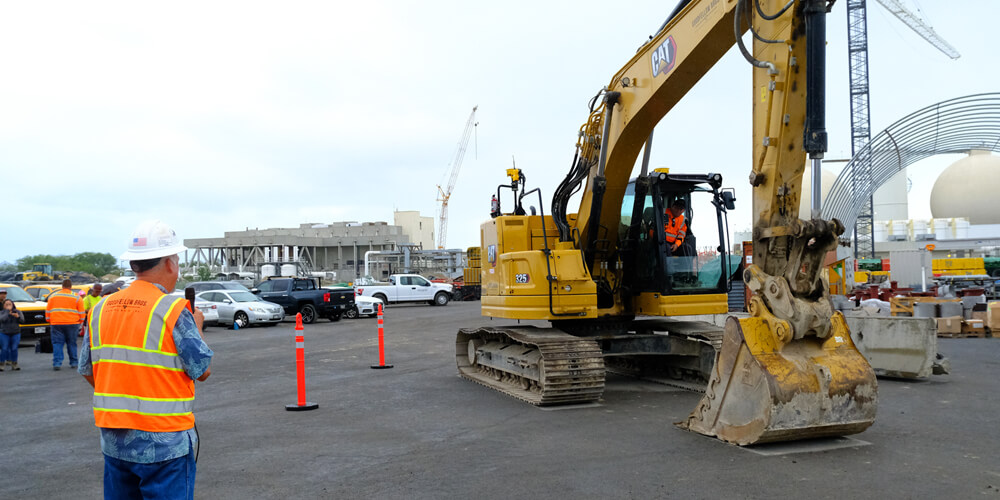
Sensory technology and monitors built into an excavator, similar to what is installed on the dashboard of cars, allow operators to monitor blindspots to avoid safety incidents at job sites or in confined public spaces where there may be pedestrians.
MAHALO TO THE GCA MEMBERS FOR THEIR CONSTRUCTION SAFETY WEEK PHOTOS!
2023 GCA SAFETY AWARDS
The annual GCA Safety Awards is further proof that safety plays an important role within the GCA. The construction industry sets a very high bar for safety and these awards are based on the same standards as the Associated General Contractors of America (AGC) Safety Awards, which recognizes companies that have achieved a “Zero Incidence Rate” — no workdays lost – or an incidence rate of 25 percent below each occupational division’s average for 2022.
“We continue to make safety a priority for our members through our annual Safety Awards, which recognizes member companies that have zero incident rates, are the best in their category, or have the most improved safety records over the previous year,” says Steve Baginski, 2023 GCA President.
“We continue to make safety a priority for our members through our annual Safety Awards...”
- Steve Baginski
2023 GCA President
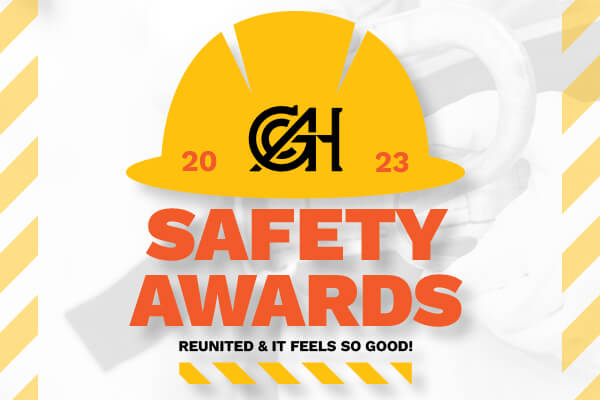
Did you register for the 2023 Safety Awards Yet?
June 14, 2023
5:30 pm HST
Hawaii Prince (100 Holomoana St, Honolulu, HI 96815)
The theme of the Safety Awards is “Reunited and It Feels So Good!” because this is the first event in three years with NO COVID-19 RESTRICTIONS!
[ SPONSOR HERE ]

The GCA asked our members for their insights on safety and what their companies are doing to integrate safety in their operations. Mahalo to the GCA members that participated!
Q: What is one of the most important factors in creating a culture of safety?
Herman Hamada (Koga Engineering & Construction, Inc.):
Top-to-bottom implementation and support is a key.
Ron Mitchell (Hensel Phelps):
The most important factors in creating a culture of safety is to have safety supported at all levels of the organization with a clear safety commitment and expectation from the most senior leaders of the organization.
Stanley Fuller III (Moss & Associates):
The most important factor in creating a culture of safety is support and participation from the top down. Supporting efforts that build a strong safety culture and participation of leadership in safety initiatives makes all the difference. This is especially vital for those on the front lines, managing the hourly trade workers. Another factor for success is creating a solid foundation for a culture of safety that is sustainable for the future but agile enough to adjust as the business or industry changes.
Q: What are some of the most challenging aspects of establishing or maintaining safe job sites?
Herman Hamada (Koga Engineering & Construction, Inc.):
As projects progress along, trades come in and out, making the interactions and coordination a key aspect.
Ron Mitchell (Hensel Phelps):
Some of the most challenging aspects of establishing and maintaining safe job sites is the ever-changing nature of construction projects. Construction projects are in a constant state of change. Changes include the physical site conditions, weather, the surrounding community, the people working on the site...Ensuring good communication pm all of the ‘changes’ is a monumental task.
Stanley Fuller III (Moss & Associates):
There are several challenges that I have seen and two that top my list. First, is the challenge of creating “trusting relationships.” With a Full-Time Safety Professional (FTSP) on site, it is imperative that they become a trusted member of the project team. Everyone from the project leadership to hourly trade workers should see the FTSP as a resource of information; a partner in the build; and an advisor on all new or hazardous activities. The second challenge is engaging the field supervision and project management team to be a part of the safety effort every day. If these two challenges are met, the project site will be better for it.
Q: Has new technology that has been introduced into the job site made it easier or more difficult to maintain a safe environment?
Ron Mitchell (Hensel Phelps):
Some technology makes it easier for the construction team to visualize some of the physical changes and challenges that will be encountered making planning for safety more efficient and effective!
Stanley Fuller III (Moss & Associates):
Currently, an Environment, Health & Safety (EHS) platform is being used to actively engage the project team on site for safety. It is software that provides accountability for staff to participate in activity and safety observations periodically during the week. It then provides measurable data and feedback for our Safety professional and project teams to proactively focus on specific activities that potentially could be hazardous. We continue to seek innovative new AI technology to create a safer workplace. One technology is a monitoring hardware and platform that detects some common construction safety hazards. This health and safety monitoring system is able to track employee vitals, personal heat illness, allows for mass notification in the event of emergencies, and is even able to detect falls. Another system identifies potential “struck by” hazards, one of the high-risk conditions on job sites. Any of the technologies we look at will require the collaboration of all team members, from project leadership, subcontractors, and trade workers, to ensure its success and to be sustainable. The challenge will always be cultural, that needs to continually be our focus to implement a holistic safe environment for all.
Q: What are some ways your company instills the importance of safety to your employees?
Tracy Lawson (Lawson & Associates):
Establishing core values, hiring the right people, and putting them in the right job positions. It’s also important to make safety a part of the entire organization's processes, not a separate function that is only handled by the safety person.
Grace Doike-Foreman (Oahu Plumbing & Sheet Metal, Ltd.):
Having a dedicated Safety Manager is important not only to manage safety compliance, but also to let employees know that safety is important and that the company is dedicated to maintaining a safe working environment for their employees by being willing to invest in a paid full-time position for safety. Utilization and interactions with apps/software for staff to use for toolbox talks, daily huddles, stretching, certifications, and other information also help to reinforce safety.
Ron Mitchell (Hensel Phelps):
Providing safety indoctrination to all employees on day 1 of employment and providing ongoing, extensive safety training.
Amy Bentz (Layton Construction Company):
It is discussed first thing daily after we stretch with all the crew out in the field. We also do our own daily PTPs and identify risks that our office staff may face.
Thomas Jacobs (Layton Construction Company):
Every morning all of our projects conduct a Daily Morning Production/Safety Huddle and Stretch & Flex. This allows all trades to communicate and coordinate their work to prevent trade stacking and rework. At this time, any safety concerns are brought up as well as anything they should need that's outside the ordinary (crane activities, deliveries, weather).
Q: Some say safety is not a program, but an ongoing process. What are some initiatives your company has implemented to help with continuous improvement in safety?
Tracy Lawson (Lawson & Associates):
Safety is a process, it is not a goal to be achieved; it is how you achieve the goal. Continuous improvement starts with having processes that add consistency to your work and understanding how systems work. This starts with looking at your current system and determining if it is meeting your expectations; then work to listen to the system (feedback loops) and change mental models of what safety is and how it can be a process improvement tool, not something that holds you back.
Grace Doike-Foreman (Oahu Plumbing & Sheet Metal, Ltd.):
Periodic incentives to identify safety issues in their work area and submitting photos into a drawing to win a prize like a Yetti Cooler, etc. Having certified instructors come to the office to conduct an in-house training for certifications instead of sending the employees out in smaller groups for the same training or certifications encourages teamwork, offers convenience, and provides consistency with the information trained to all company employees attending.
Ron Mitchell (Hensel Phelps):
One of the most successful initiatives that we have implemented is pushing more safety accountability down to our craft at the lowest levels. The craft are empowered to identify potential hazards and make the required adjustments to perform the work safely.
Amy Bentz (Layton Construction Company):
We send out weekly safety topics to all our employees in Hawaii. We have monthly safety focus topics that are discussed with all our subcontractors out in the field. We review monthly reports that contain safety data companywide such as our lost time incident rates, most common injuries for that month, etc.
Thomas Jacobs (Layton Construction Company):
Safety 360 and LaPSZ 30. Safety 360 is safety everyone, everywhere, every day. This helps to reinforce the culture of safety and serve as reminder that it is everyone's responsibility to help provide a safe working environment for all on site. LaPSZ 30 encourages everyone once they get to the area where they will be performing their work to look 15’ in all directions — left, right, above, and below. This will help you identify any potential hazards and sure your work does not affect other trades, and their work does not impact you.
We hope you enjoyed this featured article! Comments or feedback? Send an email to communications@gcahawaii.org.
Mahalo!
